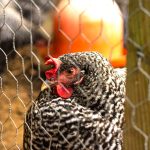Chickens are diurnal creatures, primarily active during daylight hours and resting at night. However, their nighttime behavior can be influenced by various factors, including predator presence, discomfort, or egg-laying urges. Understanding nocturnal chicken behavior is essential for providing a safe and comfortable coop environment.
During nighttime hours, chickens instinctively seek roosting spots for perching. This behavior serves as a natural security measure while they sleep. Chickens may also be attracted to nesting boxes at night, particularly if they are experiencing stress or lack adequate roosting options.
It is crucial to monitor chickens’ nighttime behavior to identify any signs of distress or underutilization of provided roosting areas. Observing chicken behavior at night allows caretakers to assess the effectiveness of their coop design and make necessary adjustments to ensure the birds’ well-being. Proper roosting areas and nesting boxes, along with protection from predators, contribute to a healthy and stress-free environment for chickens during nighttime hours.
Table of Contents
- 1 Providing Adequate Roosting Options
- 2 Installing a Roosting Bar or Perch
- 3 Using Dividers or Curtains to Block Nesting Boxes
- 4 Providing Distractions or Enticements Away from Nesting Boxes
- 5 Regularly Checking and Removing Chickens from Nesting Boxes
- 6 Ensuring a Safe and Secure Coop Environment
- 7 FAQs
- 7.1 What are some effective ways to keep chickens out of nesting boxes at night?
- 7.2 Why is it important to keep chickens out of nesting boxes at night?
- 7.3 How can a secure coop help keep chickens out of nesting boxes at night?
- 7.4 What role does lighting play in keeping chickens out of nesting boxes at night?
- 7.5 How can deterrents such as fake eggs or golf balls help keep chickens out of nesting boxes at night?
Key Takeaways
- Chickens are naturally inclined to roost at night and prefer elevated perches for sleeping
- Providing multiple roosting options at different heights and materials can accommodate different chicken preferences
- Installing a roosting bar or perch that is wide enough for chickens to comfortably grip and sleep on is essential
- Dividers or curtains can be used to block off nesting boxes at night to discourage chickens from sleeping in them
- Providing distractions or enticements such as treats or toys can encourage chickens to roost elsewhere at night
- Regularly checking and removing chickens from nesting boxes at night can help reinforce roosting behavior
- Ensuring a safe and secure coop environment is crucial for the well-being of chickens at night
Providing Adequate Roosting Options
Comfortable Roosting Bars
Roosting bars or perches should be installed at a comfortable height for the chickens to access, and they should be wide enough for the chickens to comfortably perch on. Additionally, the roosting bars should be placed away from nesting boxes to discourage chickens from sleeping in them.
Adequate Roosting Space
It is also important to consider the number of roosting spots available, as chickens prefer to roost together in a group. Providing enough roosting space will prevent overcrowding and potential conflicts among the chickens.
Protection from Predators
Furthermore, the roosting area should be elevated off the ground to protect the chickens from potential predators that may enter the coop at night. By providing adequate roosting options, you can ensure that your chickens have a comfortable and secure place to rest at night.
Installing a Roosting Bar or Perch

Installing a roosting bar or perch in the coop is essential for providing chickens with a designated spot to rest at night. The roosting bar should be installed at a height that is comfortable for the chickens to access, typically around 2-4 feet off the ground. It should also be wide enough for the chickens to comfortably perch on, with a diameter of at least 2 inches to provide stability and prevent foot injuries.
When installing a roosting bar, it is important to consider the spacing between multiple bars to accommodate the size of your flock. The bars should be spaced at least 12-15 inches apart to prevent overcrowding and allow enough space for each chicken to perch comfortably. Additionally, the roosting bar should be positioned away from nesting boxes to discourage chickens from sleeping in them and prevent soiling of the eggs.
Using Dividers or Curtains to Block Nesting Boxes
To discourage chickens from sleeping in nesting boxes at night, dividers or curtains can be used to block off access to these areas. Dividers can be installed within the coop to create separate sections for roosting and nesting, preventing chickens from accessing the nesting boxes at night. Curtains can also be hung in front of nesting boxes to create a visual barrier and deter chickens from entering these areas.
By using dividers or curtains to block nesting boxes, you can encourage chickens to utilize the designated roosting areas instead. This will help maintain the cleanliness of the nesting boxes and prevent eggs from being soiled by chicken droppings. Additionally, it will create a more organized and structured environment within the coop, promoting better sleeping habits for the chickens.
Providing Distractions or Enticements Away from Nesting Boxes
To further discourage chickens from sleeping in nesting boxes at night, providing distractions or enticements away from these areas can be beneficial. This can include placing treats or toys in the designated roosting area to attract the chickens and encourage them to spend their nights there instead. Additionally, ensuring that the roosting area is comfortable and inviting with clean bedding and proper ventilation can also entice chickens to choose this spot for resting.
Creating a positive and appealing environment in the roosting area will help shift the chickens’ focus away from nesting boxes and towards a more suitable sleeping spot. By providing distractions or enticements away from nesting boxes, you can effectively redirect the chickens’ behavior and encourage them to establish better sleeping habits in the coop.
Regularly Checking and Removing Chickens from Nesting Boxes

Nightly Checks for Proper Sleeping Habits
Regularly checking and removing chickens from nesting boxes at night is essential for maintaining cleanliness and preventing soiling of eggs. This can be done by conducting nightly checks in the coop to ensure that all chickens are roosting in their designated area and not sleeping in nesting boxes. If any chickens are found in nesting boxes, gently removing them and placing them on the roosting bar can help reinforce proper sleeping habits.
Establishing a Routine for Clean Nesting Boxes
Consistently checking and removing chickens from nesting boxes will help establish a routine and encourage them to utilize the designated roosting area for resting at night. This practice will also help prevent the accumulation of droppings in nesting boxes, maintaining a clean and hygienic environment for egg laying.
Benefits of a Clean and Hygienic Environment
By maintaining a clean and hygienic environment, you can ensure the health and well-being of your chickens, as well as the quality of the eggs they produce.
Ensuring a Safe and Secure Coop Environment
Ensuring a safe and secure coop environment is crucial for promoting healthy sleeping habits in chickens at night. This includes implementing measures to protect the coop from potential predators such as raccoons, foxes, or owls that may pose a threat to the chickens while they rest. Installing sturdy locks on coop doors, securing windows with predator-proof mesh, and reinforcing fencing around the coop can help deter predators and keep the chickens safe.
Additionally, providing adequate ventilation and insulation in the coop will help regulate temperature and humidity levels, creating a comfortable environment for the chickens to rest in. Proper lighting can also be beneficial for guiding chickens to their roosting area at night and discouraging them from wandering into nesting boxes. In conclusion, understanding the behavior of chickens at night and providing them with adequate roosting options are essential for promoting healthy sleeping habits in the coop.
By installing roosting bars or perches, using dividers or curtains to block nesting boxes, providing distractions or enticements away from nesting boxes, regularly checking and removing chickens from nesting boxes, and ensuring a safe and secure coop environment, you can create a comfortable and inviting space for your chickens to rest at night. By implementing these strategies, you can help maintain cleanliness, prevent egg soiling, and promote overall well-being for your flock.
If you’re struggling with keeping chickens out of nesting boxes at night, you may want to consider upgrading your chicken coop. Hannah Montana Chicken Coop offers some great tips on how to choose the best coop for your chickens, including features that can help prevent nesting box issues. Check out their article here for more information.
FAQs
What are some effective ways to keep chickens out of nesting boxes at night?
Some effective ways to keep chickens out of nesting boxes at night include using a secure coop with a separate roosting area, providing adequate lighting in the coop, and using deterrents such as fake eggs or golf balls in the nesting boxes.
Why is it important to keep chickens out of nesting boxes at night?
It is important to keep chickens out of nesting boxes at night to prevent them from soiling the eggs, which can lead to contamination and lower egg quality. Additionally, allowing chickens to sleep in nesting boxes can lead to overcrowding and potential aggression among the birds.
How can a secure coop help keep chickens out of nesting boxes at night?
A secure coop with a separate roosting area can help keep chickens out of nesting boxes at night by providing a designated space for them to sleep. This can help discourage them from using the nesting boxes for roosting and ensure that the eggs remain clean and undisturbed.
What role does lighting play in keeping chickens out of nesting boxes at night?
Adequate lighting in the coop can help keep chickens out of nesting boxes at night by making the nesting boxes less appealing for roosting. Chickens are naturally drawn to dark, secluded spaces for sleeping, so providing sufficient light in the coop can help deter them from using the nesting boxes for this purpose.
How can deterrents such as fake eggs or golf balls help keep chickens out of nesting boxes at night?
Deterrents such as fake eggs or golf balls can help keep chickens out of nesting boxes at night by occupying the space and discouraging the birds from roosting there. Chickens may be less likely to use nesting boxes for sleeping if they are already occupied by objects that resemble eggs.
Meet Walter, the feathered-friend fanatic of Florida! Nestled in the sunshine state, Walter struts through life with his feathered companions, clucking his way to happiness. With a coop that’s fancier than a five-star hotel, he’s the Don Juan of the chicken world. When he’s not teaching his hens to do the cha-cha, you’ll find him in a heated debate with his prized rooster, Sir Clucks-a-Lot. Walter’s poultry passion is no yolk; he’s the sunny-side-up guy you never knew you needed in your flock of friends!







